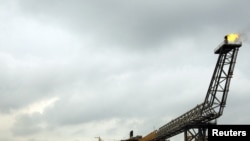The Iranian Mehr news agency quoted Javad Oji, executive director of Iran’s National Gas Export Company, as saying over the weekend that the two neighboring states have held “numerous negotiations” on the matter in recent years. Oji said his company could deliver up to 2.3 billion cubic meters of gas to Armenia in the near future.
The Armenian Ministry of Energy and Natural Resources on Tuesday declined to comment on this.
The figure cited by Oji exceeds the current volume of Armenian gas imports from Russia. The Russian Gazprom monopoly has remained the country’s main gas supplier even after the construction of the Armenia-Iran pipeline that was officially completed in late 2008.
Armenia began importing modest amounts of Iranian gas through that pipeline in May 2009. The annual volume of these deliveries has not surpassed 400 million cubic meters.
Under an Armenian-Iranian supply contract signed in 2004, Armenia was due to buy 3 million cubic meters of gas a day. A senior Iranian gas executive complained in late 2009 that the actual amount of gas supplies is well below that level and said the Iranian side could demand a compensation for the shortfall from Yerevan.
Armenian Energy Minister Armen Movsisian dismissed these complaints at the time. Movsisian said the 2004 contract also stipulates that Armenia will import the planned amount of Iranian gas only after being able to pay for it with large-scale electricity supplies. That will happen only after the construction of a third transmission line linking the Armenian and Iranian power grids, he said.
Movsisian and his Iranian counterpart, Majid Namju, announced the start of work on that high-voltage line after talks in Yerevan last October.
Movsisian and other Armenian energy officials have still not disclosed the price of Iranian gas. The price has taken on greater significance in the last few years amid sharp increases in the cost of Russian gas imported by Armenia.
Commentators in Yerevan now wonder whether it is now more expensive than the gas pumped from Iran. Some of them claim that the Armenian energy sector has not become more reliant on the Islamic Republic because of its heavy dependence on Russia.
Gazprom has a controlling share in Armenia’s national gas distribution network. The latter also owns the entire Armenian section of the pipeline from Iran.





